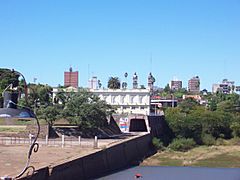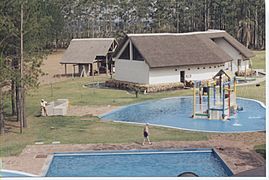Salto Department facts for kids
Quick facts for kids
Salto
|
|||
|---|---|---|---|
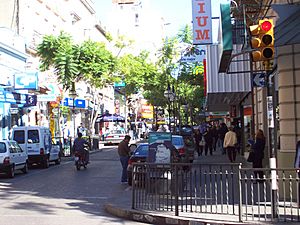
A street in the city of Salto.
|
|||
|
|||
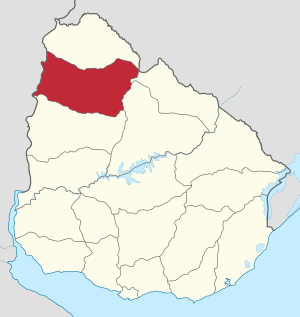
Location of Salto, in red, in Uruguay
|
|||
| Country | |||
| Creation | 17 June 1837 | ||
| Capital | Salto | ||
| Area | |||
| • Total | 14,163 km2 (5,468 sq mi) | ||
| Population
(2011)
|
|||
| • Total | 124,878 | ||
| • Density | 8.8172/km2 (22.8364/sq mi) | ||
| Time zone | UTC-03 (UYT) | ||
| ISO 3166 code | UY-SA | ||
| Website | Official website: http://www.salto.gub.uy/ | ||
The Salto department (called Departamento de Salto in Spanish) is a region in Uruguay. It's like a state or province. The main city and capital of this department is Salto. Its special code is UY-SA.
Contents
What's in a Name? The Story of Salto
The name "Salto" comes from the waterfalls that used to be in the Uruguay River. In Spanish, "Saltos" means "waterfalls" or "jumps." These waterfalls were a big part of the area's history.
History of Salto Department
The Salto department was created a long time ago, on June 17, 1837. Back then, it was much bigger. It even included the area that is now the Artigas Department.
Later, on October 1, 1884, the borders of Salto were changed. The Artigas department became its own separate area. This set the final shape of Salto as we know it today.
Exploring Salto's Geography
The Salto department is located in the northwestern part of Uruguay. It covers a large area of about 14,163 square kilometers (5,468 square miles). This makes it the second-largest department in the country.
Salto is also home to many people. It's the fourth most populated department in Uruguay. In 2011, about 124,878 people lived there. This means the area has a population density of about 10.5 people per square kilometer.
Hills and Valleys: Salto's Landscape
The department has two main chains of low, rounded hills. These hills are called cuchillas in Uruguay.
- The cuchilla de los Arapeyes is in the northern part of Salto.
- The cuchilla del Daymán stretches across the department from the southeast to the northeast.
Between these two hill chains, you'll find the valley of the Arapey Grande river.
Where is Salto? Its Neighbors
Salto department shares its borders with several other areas:
- North: The Artigas department.
- East: The Rivera and Tacuarembó departments.
- South: The Paysandú department.
- West: Argentina, separated by the Uruguay River.
 |
Artigas department | Rivera department |  |
|
| Argentina | Tacuarembó department | |||
| Paysandú department |
Important Rivers of Salto
Several important rivers flow through or along the Salto department:
- The Uruguay River is on the western side. It forms the natural border with Argentina.
- The Arapey Grande River is a smaller river that flows into the Uruguay River.
- The Daymán River is in the south. It also flows into the Uruguay River and marks the border with the Paysandú department.
Salto's Climate: Warm and Humid
The climate in the city of Salto is known as a "Humid subtropical climate" (type Cfa). This means it has hot, humid summers and mild winters.
On average, Salto gets about 1,277.6 millimeters (50.3 inches) of rain each year. March is usually the wettest month, with about 137.2 millimeters (5.4 inches) of rain. August is the driest, with around 66 millimeters (2.6 inches) of rain.
The average yearly temperature in Salto is 18.1°C (64.6°F). January is the warmest month, averaging 25°C (77°F). June is the coolest, with an average temperature of 11.7°C (53.1°F).
Who Lives in Salto? Demographics
People who live in the Salto department (and in the city of Salto) are called Salteños (for boys and men) or Salteñas (for girls and women) in Spanish.
How Salto's Population Has Grown
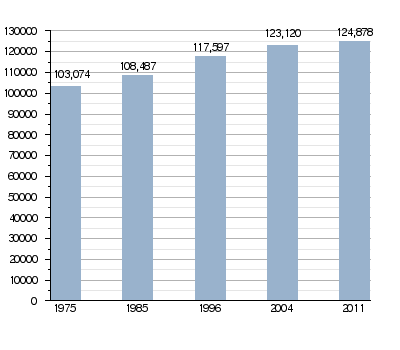
People Living in Rural Areas
In 2011, the census showed that about 7,849 people lived in the rural parts of the Salto department. This means they live outside the main towns and cities.
Main Towns and Cities
Here are the largest towns and cities in the Salto department, based on the 2011 census:
| City / Town | Population (2011) |
|---|---|
| Salto | 104,028 |
| Constitución | 2,762 |
| Belén | 1,926 |
| Pueblo Lavalleja | 956 |
| San Antonio | 877 |
Gallery
-
Treinta y Tres square, Salto.
Related Pages
See also
 In Spanish: Departamento de Salto para niños
In Spanish: Departamento de Salto para niños





